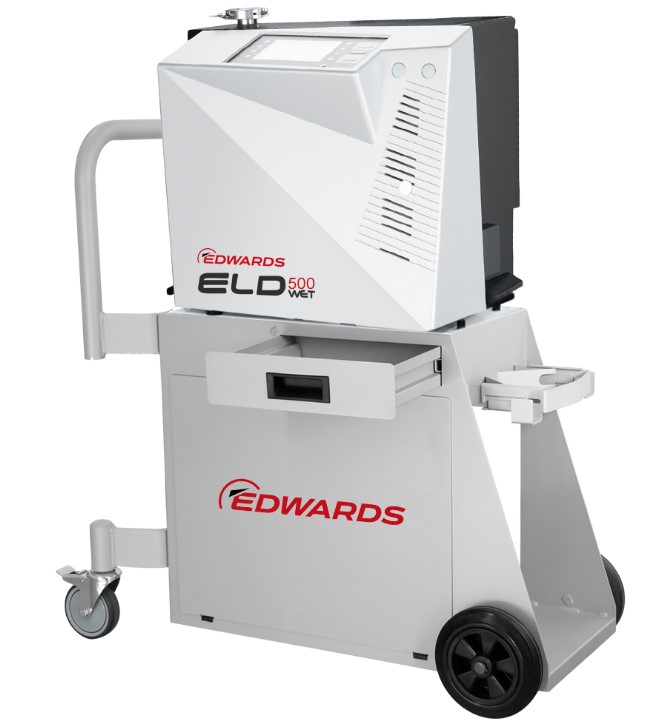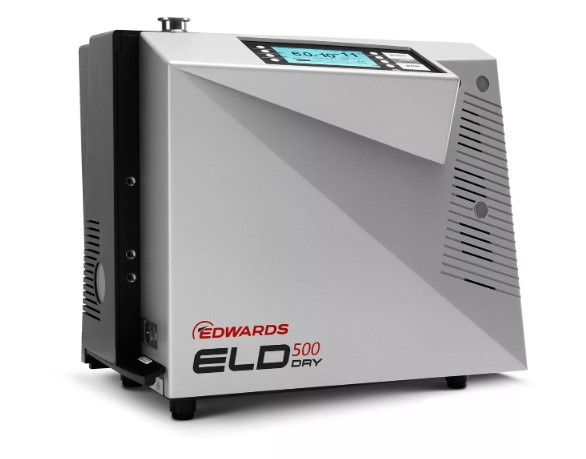 Rave Scientific
Nanotechnology Instrument Providers and Consultants
Rave Scientific
Nanotechnology Instrument Providers and Consultants
- You are here:
- Rave Scientific

- Vacuum Products

- Edwards Helium Leak Detectors
Edwards Helium Leak Detectors

Rave Scientific offers the versatile Edwards ELD500 Helium Leak detectors. Helium leak testing has its roots in the mid-20th century when helium's unique properties made it an ideal tracer gas for detecting leaks in various systems. The technique gained prominence during the space race and Cold War era, particularly in industries like aerospace and nuclear power. Today, helium leak testing is a widely used method for ensuring the integrity of sealed systems, from industrial applications to medical devices.
Leak detection with the test gas helium is safe, quantitative and repeatable. Helium leak detectors are the ideal solution for leak detection and leak-tightness testing under vacuum. The test gas helium is safe and a small, a light molecule which is suitable for detecting micro leaks. The detection range of helium in vacuum tests lies between 10-2 and 10-13 Pa · m3/s. Helium leak detection is extremely accurate, quantitative and repeatable. Fast cycle times are a further advantage. Manual sniffing or spraying is often the easiest way to detect a leak with Helium. But it is also possible to use automatic leak detection solutions which are independent of the operator and provide a considerably higher detecting speed. The integral leak detection is designed to achieve pre-defined quality and component throughput levels. The use of test gas leak detection methods has the bonus of delivering extra data compared to traditional leak detection methods such as bubble testing or pressure drop methods. These data can be used to improve production processes and successfully detect every leak.
All models feature a rugged turbomolecular pump optimized for the rigors of portable leak detection and can be configured with the optional transport cart shown here. Variants include.
- WET version with an integrated oil sealed rotary vane pump.
- DRY version with an integrated helium optimized diaphragm pump.
- FLEX version without a primary pump, ideal for trolley mounting along with a larger primary pump such as an Edwards nXDS scroll pump
- Flexible remote control options, features include.
- Color touch screen control with local graphical display
- Audible leak indication via loudspeaker or headphones
- Data logging to local memory or USB stick.
- Wired or wireless models available.
- Wireless model allows simultaneous control of up to 10 leak detectors.
- The partial flow kit allows effective pump down of large or contaminated volumes.
- Compatible with WET and FLEX variants.
- Allows automatic calculation and display of actual leak rate ͵ Enables leak detection from atmospheric pressure • Extensive range of sniffer lines available for accurate pin-pointing of leaks on pressurized systems ͵ Standard sniffer line enables operation up to 4m from the ELD500 ͵ Longer sniffer lines of up to 50m can be used with the sniffer extender interface.
Edwards Mobile Trolley Cart for the ELD500 Helium Leak Detector_Data-Sheet



- SEM Sample Holders
- (Overview of Sample Holders)
- Angled and Tilt holders
- Bulk SEM sample holders
- Centering vise holder
- C-Square Muti Pin Holders
- Compact and universal vises
- EBSD sample holders
- FIB grid holders
- Filter Disk Holders
- Geological slide holders
- Gripping stub & stub vises
- Metallographic standard and reference sample holders
- Multiple Hitachi stub holders
- Multiple JEOL stub holders
- Multiple pin stub holders
- Multi XL holder large
- Non Magnetic Sample Holders
- S Clip Sample Holders
- Sample Clamp holders
- Small sample holders
- Small vise holders
- Soft jaw lining kit
- STEM imaging holder
- Swivel tilt sample holders
- TEM grid holders
- Transmission EBSD sample holders for TEM and FIB grids
- Universal sample holder kit
- Versa-Plate Adaptable Holder
- Versatile vise clamp holders
- Wafer holders
- XT stage extender strips
- °360°/90°off-set holder
- Metallographic Mount Holders
- Multiple Metallographic Mount Holders
- Sample Preparation
- Overview-Sample Preparation
- Applicators and Swabs
- Carbon Rods & Fibers
- Conductive Adhesives
- Cutting Tools
- Gloves & Cleaning Supplies
- Lab Scissors
- Non-Conductive Adhesives
- Plastic Transfer Pipettes
- Preparation Mats and Tiles
- Probes and Picks
- SEM Preparation Stands
- SEM-TEM Remote Plasma Cleaner - IBSS Plasma
- Sputter Targets
- Stainless Steel Mesh
- Supports and Substrates
- Tweezers
- Overview Tweezers
- High Precision Tweezers
- High Prec. Reverse Tweezers
- High Prec. Locking Tweezers
- High Prec. Mini Tweezers
- High Prec. Slim tweezers
- High Prec. Titanium Tweezers
- High Pr. Super Alloy Tweezers
- Cutting Tweezers
- SEM Stub Gripper Tweezers
- Cryo Grid Box Tweezers
- AFM/SPM cantilever tweezers
- AFM/SPM Disc tweezers
- Gatan 3View Pin Tweezers
- Wafer Handling Tweezers
- Plastic Tweezers
- Repl. Plastic Tip Tweezers
- Repl. ESD Ceramic Tip Tw.
- Repl. Ceramic Tips Tw.
- Value-Tec Fine Tweezers
- Value-Tec Ceramic Tip Tw.
- Value-Tec Fibre Grip Tweezers
- Value-Tec Strong Tweezers
- Tools
- Conductive SEM Coating Fluid
- PHP-4 Array Tomography Automated Kapton Tape Glow Discharge Cleaner
- MC-4 Multi-Modular Cleaner: UV Light, Plasma and Heating for SEM and TEM Samples
- EM Filaments
- SEM Sample Stubs
- Sample Stub Adapters
- JEOL SEM Supplies
- Overview JEOL SEM Supplies
- JEOL Tungsten Filaments
- Vacuum Storage-JEOL
- JEOL SEM Sample Holders
- JEOL Calibration Standards
- Desktop-NEOSCOPE SEM Supplies
- Desktop-NEOSCOPE SEM Holders
- JEOL Multi-Stub Holders
- JEOL Denka Lab6 Emitters
- JEOL Particle Analysis Holders
- JEOL SEM Stubs
- JEOL SEM Holder Adapters
- Sample Preparation Stands-JEOL
- Sample Storage-JEOL
- In-Situ Chamber Plasma Cleaner-JEOL
- SEM Stub Gripper-JEOL
- Hitachi SEM Supplies
- Overview Hitachi SEM Supplies
- Hitachi Calibration Standards
- HITACHI TM Desktop SEM Supplies
- HITACHI TM Desktop SEM Holders
- HITACHI -In Lens Sample Stubs
- HITACHI Multiple Stub SEM Holders
- HITACHI Particle Analysis Holders
- HITACHI M4 Stubs
- HITACHI SEM Holder Adapters
- HITACHI Tungsten Filaments
- Sample Preparation Stands-HITACHI
- Sample Storage-HITACHI
- HITACHI Sample Holders
- Vacuum Storage-HITACHI
- In-Situ Chamber Plasma Cleaner-Hitachi
- SEM Stub Gripper-Hitachi
- Zeiss SEM Supplies
- Overview
- Calibration Standards Zeiss
- Zeiss SEM Holders
- Zeiss Sample Preparation Stands
- Zeiss Tungsten Filaments
- Zeiss Denka Lab6 Filaments
- Zeiss Denka 174 Schottky Emitters
- Vacuum Storage-Zeiss
- Zeiss Pin Stubs
- Sample Storage-Zeiss
- Zeiss SEM Holder Adapters
- Zeiss Particle Analysis Holders
- In-Situ Chamber Plasma Cleaner
- SEM Stub Gripper Tweezers-Zeiss
- Thermo-FEI SEM Supplies
- Overview Thermo-FEI Supplies
- Calibration Standards-Thermo-FEI
- Dual Beam TEM Grids
- Gallium LMIS-Thermo FEI
- Dual Beam Pre-Cursors
- Dual Beam TEM Grid Holders
- Dual Beam Low Profile Stubs
- FEI Dual beam EBSD-3D sample Holder
- Dual Beam Gallium Sources
- FESEM FEI XL & Sirion Source Changes
- Non Magnetic Sample Holders
- Phenom SEM Supplies-Thermo-FEI
- Phenom Tabletop SEM Stubs & Sample Holders
- SEM Sample Holders-Thermo-FEI
- SEM Pin Stubs-Thermo-FEI
- Stage Adapters-Thermo FEI
- Thermo-FEI Tungsten Filaments
- SEM Stub Grippers-Thermo-FEI
- Particle Analysis Holders-Thermo FEI
- TESCAN SEM Supplies
- Overview TESCAN SEM Supplies
- Sample Preparation Stands-TESCAN
- Calibration Standards-TESCAN
- TESCAN SEM Sample Holders
- TESCAN Tungsten Filaments
- TESCAN Denka Lab6 Cathode
- TESCAN Denka 174 TFE Emitters
- TESCAN Particle Analysis Holders
- TESCAN SEM Holder Adapters
- TESCAN SEM Stubs
- Sample Storage-TESCAN
- Vacuum Storage-TESCAN
- TESCAN FIB-SEM TEM Lift-Out Grids
- TESCAN FIB-SEM TEM Grid Holders
- TESCAN FIB-SEM Pre-Tilt Low Profile Stubs
- SEM Stub Gripper Tweezers-TESCAN
- Desktop SEM Supplies
- Vacuum Supplies
- Light Microscopy Supplies
- Sputter Targets
- Sample Storage
- Overview
- Vacuum Sample Storage
- Inert Gas Sample Storage
- Rave-Tec Membrane Boxes
- Rave-Tec Sticky Gel Carrier Boxes
- Vacuum Glass Storage
- Pin Stub Storage
- Hitachi M4 Storage Boxes
- JEOL Stub Storage Boxes
- Desiccant Box
- Barrier Foil Ziplock Bags
- Wafer Carrier Trays
- Clear Plastic Boxes
- Small Cardboard Boxes
- Magn. AFM Disc Boxes
- Rave-Tec Field and lab sampler kits and boxes
- SEM Vacuum Transfer Shuttle for air-sensitive samples
- Vacuum Transfer Test
- SEM Stage Adapters
- Cryo Supplies
- Calibration Standards
- Dual Beam Supplies
- TEM Supplies
- AFM Supplies
- Lab Supplies
- SEM Sputter Coaters
- Safematic Supplies
- Metallurgical Supplies Overview
- Compact Smart Clip Metallographic Mount Holders for SEM
- Sample Embedding Clips
- Silicone Embedding Cups
- MET-C conductive hot embedding resin powder
- Laboratory Handheld Engraving Tool & Engraving Pen
- Rave-Tec temporary mounting waxes
- Vacuum Desiccators
- Diamond Polishing Paste-Metallurgical
- PTFE beakers-Metallurgical
- Metallurgical EBSD Holders
- SEM Stage Adapters Overview
- Vacuum Products
- Edwards Vacuum Supplies
- Pfeiffer Vacuum Products
- Pfeiffer Helium Leak Detectors
- Edwards Helium Leak Detectors
- Rotary Pump Vacuum Oil
- Apiezon Vacuum Grease
- Krytox Vacuum Grease
- KF / NW Vacuum Flange Connection Hardware
- Hysol 1C / Torr Seal Vacuum Epoxy Resin Sealant kit
- Rave-Tec stainless steel vacuum chamber for degassing
- Silver and carbon conductive vacuum greases
- Metal wires and materials for vacuum evaporation
- Rave-Tec KF/NW stainless steel vacuum bellows